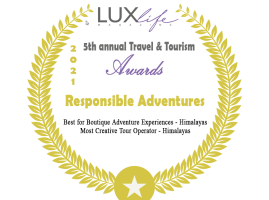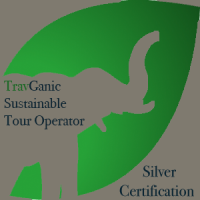Tourism in Bhutan
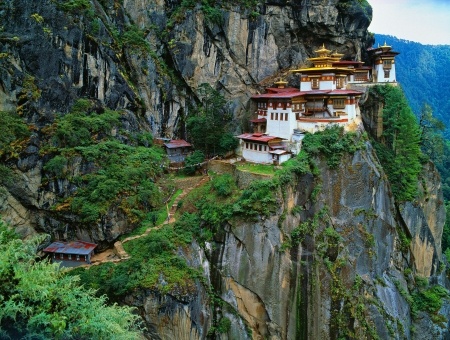
Tourism in Bhutan The Government of Bhutan allowed tourism to begin in 1974 to promote its unique culture and traditions and raise revenue in the otherwise isolated Kingdom. Bhutan government’s slogan for tourism is “Low Volume, High Quality.” Two hundred eighty-seven tourists visited Bhutan in the first year. Tourist arrivals increased steadily to 2850 in 1992 and 7158 in 1999. These days the number of visitors to Bhutan is around 80,000. Tourism is a massive contributor to the Bhutanese Government’s coiffeur and one of the biggest employers. However, the government is profoundly aware of tourism’s effect on the environment, unspoiled landscapes, and tourists’ unique culture. Therefore, they have restricted the level of tourist activity from the start, preferring higher quality tourism. Bhutan Tourism Corporation Limited (BTCL), and quasi-autonomous and self-financing body, implemented the government’s tourism policy until 1991. The Bhutanese government privatized BTCL in October 1991. These days more than 800-registered travel companies are operating in Bhutan. All individuals or groups must travel on a pre-planned, prepaid, guided package tour in Bhutan. Most foreigners aren’t allowed to go independently in the Kingdom. The arrangements must be made through a government-registered travel company or an overseas tour operator. The most important tourism centres are in the capital Thimpu, Paro’s western city, where the only international airport is located in the Kingdom. Taktsang, also called the “Tiger’s Nest,” is a monastery on a Cliffside overlooking the Paro Valley. This is an incredibly sacred temple to Buddhists. A Buddhist deity is housed in a cave in the Temple. It is believed this Deity introduced Buddhism to Bhutan and fasted for 90 days while fighting the demons that inhabited this valley to spread Buddhism. This impressive Temple has stood for more than a millennia despite two fires (the repaired damages). Punakha Dzong (fort) is another important site to visit. It is the second-largest Dzong in Bhutan and is still a significant ceremonial venue for the Royal family. For example, the current king’s coronation and the wedding took place here. Druk Air, the National Carrier, and Bhutan Airlines (private airlines) operate flights in and out of Bhutan. The current minimum daily package includes the following: 1) A minimum of 3-star accommodations – you can upgrade to 4 and five stars for an additional charge. 2) A licensed Bhutanese tour guide for the period of your tour package. 3) All transportation by road (excludes domestic flights), if you are also trekking – camping equipment and portage of all gears and food during the trekking period. 4) It includes all permits, entrance fees, and meals – breakfast, lunch, and dinner. The minimum daily package cost for tourists travelling in a group of 3 or more during the low season months of January, February, June, July, August, and December is US$200 per person per night. The minimum daily package rate for tourists visiting in a group of 3 or more during the high season months of March, April, September, October, and November is US$250 per night per person. If you are a single traveller, the government charges an additional F.I.T. surcharge of US$40 per night. If there are two of you, you must pay an additional US$30 per night for your Bhutan tour. The Royal Government of Bhutan sets minimum selling prices for packages to Bhutan. These must be paid in U.S. dollars before arrival in Bhutan. Cancellation Please discuss with your service provider (tour operator) the cancellation policy. All Bhutan Tours are prepaid, so you’ll only need money for drinks, laundry, souvenirs, and tips; for this, it is best to bring cash. A.T.M.s are available in most main towns. However, it would be wise not to rely entirely on being able to use plastic. Credit cards are accepted in some hotels and souvenir shops, but only in major cities or “tourist” areas. The currency unit is the Ngultrum (Nu), pegged to the Indian rupee. The Ngultrum is further divided into 100 chetrums. Indian rupees are used freely throughout Bhutan (don’t be surprised if you get the change in rupees). Officially 500 and 1000 Indian rupee notes are not accepted due to large counterfeit bills. It is OK with the Bhutanese to bring a reasonable amount of Indian currency into Bhutan, though Indian regulations prohibit currency export.
Annapurna Circuit trek with Tilicho lake during the winter
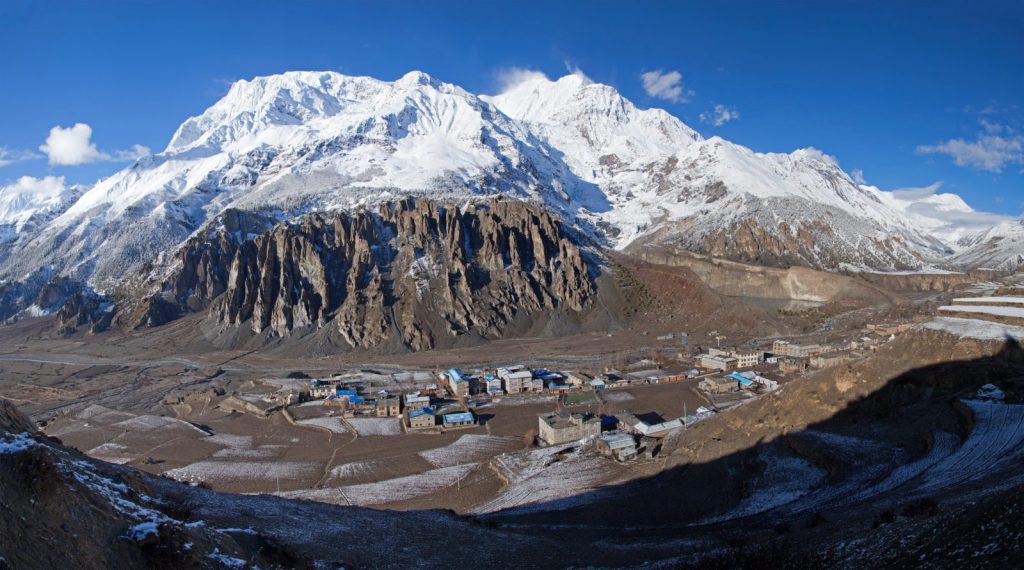
Annapurna Circuit trek with Tilicho Lake during winter. January 2018. Andrew and I had agreed to discuss a second trek on which he could go after his family trek on our communications. We decided to go on the Annapurna Circuit with Tilicho Lake. It met his requirements of relatively easy accessibility, which could be done within two weeks, visiting a glacial lake and going over 5000 meters. We decided to start on the 8th of January, two days after his family left for Hong Kong. While Andrew was in Pokhara and Chitwan with his family, I returned to Kathmandu to get the necessary permits, the needed information, etcetera. The Drive to Besishar. We had agreed to hire a car from Besisahar to a blacktopped road; from Besisahar, we had to hire a local Indian jeep. My local transporter in Besisahar advised me to start from Kathmandu early as a small section of the road freezes in the late afternoon. Andrew and I agreed to leave Kathmandu at 5 am with some packed breakfast and coffee to avoid the frozen section of the fair-weather road to Chame – our destination for the first night. I went to pick up Andrew with a slight delay as the designated driver’s mother-in-law turned ill, and he had to be replaced by another person. We managed to get out of Kathmandu valley smoothly as it was still early. Driving into or out of Kathmandu can be nightmarish, with delays as long as 3-4 hours. We had clear views of the Manaslu and Annapurna range on the drive to Besisahar. We reached Besishar on schedule after 5 hours of driving. Besisahar to Chame Drive. 2600m. We changed vehicles and were driven off after showing the permits to the registrar. Andrew and I had booked a whole jeep – Mahendra Bolero for us. I asked the driver to call a restaurant to make dal bhat (Nepalese staple diet) in advance to save time. The road was rough with huge rocks making it very bumpy for the first half. We stopped for a quick lunch, which was ordered in advance. We picked up a few hitchhikers, including a goat with difficulty walking. The road became less bumpy once we entered the district of Manang. We managed to get through several icy parts of the way with no trouble and arrived at Chame at 5 pm, 11 hours since we left Kathmandu. The views of the mountains from the Manaslu range to the east and Lamjung Himal to the south were unobstructed all day long, despite nearly 30 years of trekking I had never experienced. We checked into a lovely lodge with cottages and had the whole place to ourselves. We went to our cabins to sort everything for the night before gathering in the dining room, where pleasant warmth from the heater welcomed us. We had some Rakshi (locally distilled drink). We checked out the weather forecast on the Internet, and the predictions for Manang village, 3500meters, were -18 minimum and -9 maximum. We were getting there in two days. The temperature for Throung La past the 16th of January was forecasted to be -11 maximum and -24 minimum. This raised some concerns for me. We went to bed early after Andrew roughly ground the coffee beans he had brought to get the well-needed rest. We woke up at 7 am, packed our backpacks, and met in the dining room for fresh coffee, which Andrew had ground the previous evening. The weather app on our devices showed the temperature to be -9 degrees Celsius; I was wearing a pair of socks and my slippers – my feet did not feel cold or uncomfortable. I shared this with Andrew and mentioned this felt odd, but the lack of discomfort was welcome at the same time. However, the water in the bucket inside the toilet was frozen solid, while the toilet floor was icy with the spilt water. The Trek to Upper Pisang 3200m. This was a short day of five hours of trekking amidst beautiful scenery. We decided to take our time to absorb the surrounding beauty and took many photographs. We passed through a series of Mani walls. We arrived at the apple orchards at Brathang and stopped at the farmhouse for some hot lemon drinks. We were down to our T-shirts by this time, which was a pleasant surprise, having been at supposedly -9 degrees Celsius just a few hours ago. We had to climb a moderate hill after crossing a bridge; we went through Juniper, Pine, and Fir forests. The valley began to broaden, and Pisang Peak 6091m stood in front of us, while in the back were the impressively broad rock walls the locals call “Heaven’s gate.” We stopped at Dhikur Pokhari for lunch. We had a short walk to Upper Pisang after lunch. While walking on the fair-weather road track, Andrew slipped on ice camouflaged by dirt. It quickly reminded us that we were, after all, trekking in the Himalayas during winter. We saw less than ten trekkers on this day. We stayed at Tukuche lodge at Upper Pisang, and there were two backpackers there; one Swedish and the other one from South Korea. Trek to Manang Village. There are two options to get to Manang – the shorter lower route or, the more extended but more scenic Upper route. We opted for the more beautiful and higher way, which also helps with acclimatization to high altitudes. We started around 8.30 am and were in the sun after thirty minutes of hiking. We walked above a picturesque lake to our left. We walked on a reasonably level path through scrubland before coming across a long Prayer wall, descended a little to cross a stream on a suspension bridge, and began a strenuous climb with switchbacks to the village Ghyaru 3673m. We were greeted by Lamjung Himal’s views, Annapurna II, IV, III, Gangapurna, and Mount Tilicho. We had a short stop to rehydrate and
Annapurna base camp trek during the monsoon season
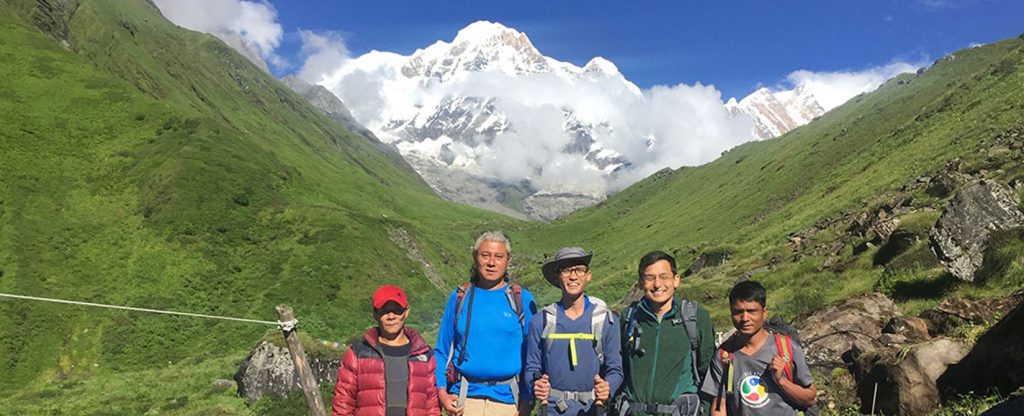
Annapurna Base Camp Trek during the monsoon season Day 1: I returned home the previous night after finishing the Helambu trek with a family. I got up after a restful sleep. My new trekkers consisting of a father and son from Singapore, arrived this afternoon, landing at 12.30 pm. I met them, walked to the domestic airport, and caught a 2.50 pm flight to Pokhara on the same day. I was getting ready to pack up while checking my Flightstats app on their flight status. It showed that their plane was to land 25 minutes before the estimated arrival time (ETA). We had agreed to meet outside the arrival terminal, and they were given my description, although I was already connected to Kevin – the dad, on Facebook and WhatsApp. The father and son trekkers – Kevin and David Kho. When they came out of the arrival terminal, I waved at them, and they walked toward me. We had a quick handshake, they were welcomed to Nepal, and we walked over to the domestic terminal, which is less than a 10-minute walk from the International Terminal. After going through the security check for a light meal, we went to the restaurant. Then, we boarded the flight on time for a short 25-minute flight to Pokhara. We saw some Himalayan Summits peeking out of the monsoon clouds on the flight. Upon landing in Pokhara, we boarded our pre-booked van to our hotel and agreed to meet up to go for a walk along the Lakeside shops to purchase what they needed for the trek. We were lucky to see Mount Machapuchare (Fishtail) 6993 m with fresh monsoon snow. It had more snow now than the rest of the year. We had an early dinner of tandoori chicken, fish, and naan before retiring for the night. Day 2: We woke up early for our 6.30 am breakfast. We had a two-and-a-half-hour drive to our starting point, followed by a 3-4 hour uphill trek to our next destination, Chomrong. We stopped and picked up our support crew after an hour of driving and continued. Fifteen minutes before we reached our stop, we had to change into another jeep on the other side of a small landslide, which had taken place the previous night. We were informed that falling rocks had injured a local trekker on the Westside of the Modi River’s regular trail. The rockfall was caused by an excavator constructing a new road. We had to walk on the newly made path east of the Modi River. I briefed the Singaporean trekkers on being careful on the wet stone, slippery roots, and trail and avoiding moist areas to avoid leeches. In advance, we stopped at New Bridge for lunch ordered by Ram, our porter. We had another two and a half hours of the uphill trek until we reached Chomrong village, our destination for the day. We were making good time on the hike when it started to rain 35 minutes before Jhinu Danda. We decided to stop here – an hour before our target destination to avoid walking in the rain, and we didn’t want to exert the trekkers on the first day as they had a very early start. We had time to enjoy some hot beverages and hang our wet clothes to dry at the lodge. Kevin and David’s trekkers talked about Nepal, its topography, and ethnology before dinner. They retired early to get ready for a long trek the following day. Day 3: We got up early with our Ayurvedic energy-boosting drink as usual and started the day before at 7.30 am to get into camp before 3.30 pm to beat the rain. We had a steep 300 meters of climbing to Chomrong village. They made a good time getting to Chomrong, and we discussed pushing on to Bamboo, which was a further 4 hours away for lunch, so we had only an hour to our final stop at Doban. This was a physically demanding day as, after the 300-meter climb, we had to descend on steps down to Chomrong river and a 75-minute ascend to Sinuwa at 2340 m. I asked the trekkers if they were hungry or needed to get some snacks, as there was nothing once we left this place until we reached Bamboo for lunch. The area from now on until Annapurna Base camp and back is called the particular management area. No bottled water is allowed for environmental reasons, and fresh or dried meat for religious beliefs. During the “off-season,” the lodge owners take annual turns to man each stop: One lodge will serve food; however, if there is a need for more rooms, the other lodge owners leave the room keys operating lodge owner so trekkers can sleep in their lodges. We trekked through a lush area of Oak, Rhododendrons, and Bamboo forest with numerous waterfalls. The last time I hiked in this area was during the Christmas period of 2014. Then, I noticed that the lodge owners had widened the trails, laid slates, and made steps to conserve the path, and the difficult rocky trail had been flattened. We reached Bamboo at 1 pm and were served our order of mixed fried noodles within a few minutes as Ram, our porter, had gone ahead of us to order our lunch. It takes 60-90 minutes for meals to get ready, as it is freshly prepared. Kevin loved the fried noodles and said that these particular noodles would do very well in Singapore (he was in the food business for six years, so I guess he knows what he is talking about). The cook of the lodge was delighted when I told him this. Feeling energetic after a sumptuous meal, we continued to Doban 2600 m, our daily stop. We were glad to have covered an extra hour of walking with no problems for anyone. Upon getting there, we learned that two other trekkers were going towards Basecamp, and a big group of 19 trekkers
Amazing photos of Ladakh that will give enough reasons to want to go trekking
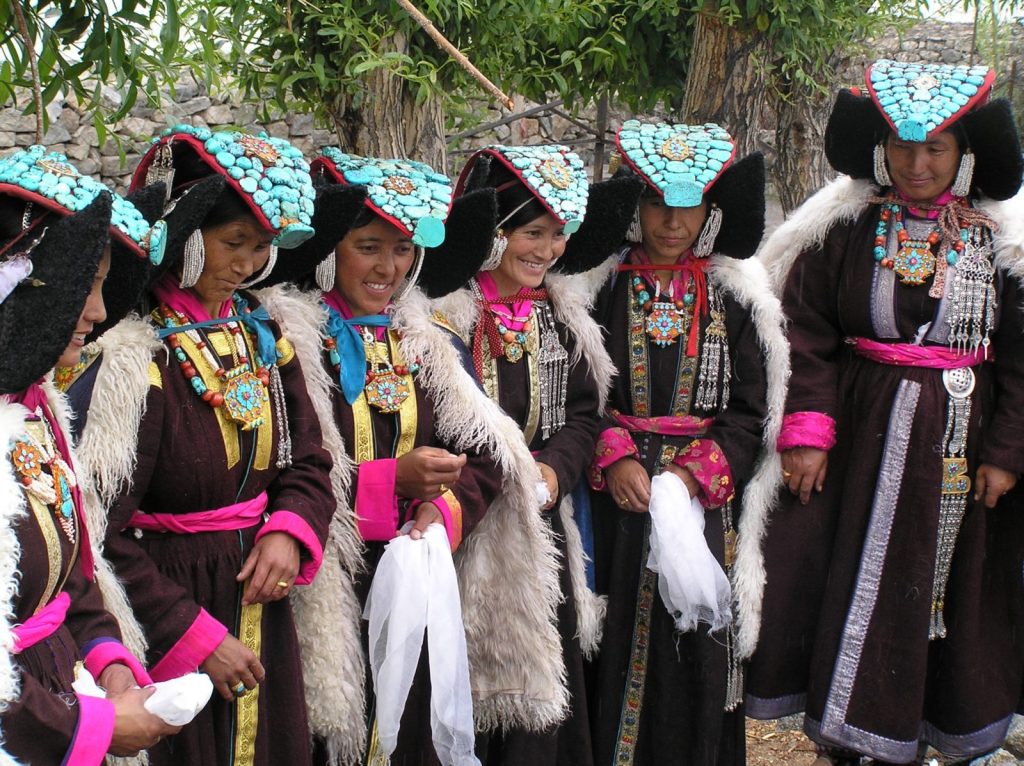
Amazing photos of Ladakh that will give enough reasons to want to go trekking There are green valleys amidst the dry high mountains in the cold desert. Trek past numerous Buddhist monuments such as the Chortens while trekking in Ladakh. Trekking in Ladakh can be hot as the season is during the Northern Hemisphere’s summer. Enjoy a fantastic array of colours on the Markha valley trek. Bask in the sun while enjoying your healthy breakfast before starting your trekking day. Enjoy camping amidst stunning landscapes. There are numerous Himalayan Peaks in Ladakh. I am enjoying breathtaking scenery while trekking in Ladakh. The trekking trails in Ladakh are full of Buddhist prayer walls. Buddhism is primarily practised in all parts of Ladakh. Enjoy breathtaking sunrises and sunsets while trekking in Ladakh. The locals tie prayer flags on the passes to show gratitude to the gods for good weather on their crossing. Mount Khang Yatse, 6400 meters, is the highest peak on the Markha Valley trek in Ladakh. Rumbak is a village with high snow leopard sightings during winter. Rumbak is where most documentaries on Snow leopards are made. A hard day over a 5000-meter pass can be rewarding with scenery like this. Camp in high summer pastures on the Markha Valley trek. See Ladakhi ladies in traditional costumes during the Leh Festival in September. Go hiking over several high passes that are above 5000 meters in altitude. Make friends with curious donkeys while trekking in Ladakh. Watch street vendors selling fresh organic vegetables and fruits on the streets of Leh. Stok Khangri, 6153 meters, dominates the southern skyline in Leh. Lake Tsomoriri lies in the Changtang region of Ladakh. Changtang – Northern plateau is the continuation of the Tibetan plateau. It is home to many migratory birds critically endangered during the summer. Tsomoriri lake is 4 km wide and 40 km long. Have a cultural immersion with Changpa nomads of the Changtang plateau. Thikse Monastery is 7 km out of Leh town. One can visit it in pre-dawn to hear Gelukpa monks chant during dawn. Check out our Trekking packages for Nepal, Bhutan, India, and Tibet.
Amazing Festivals of Bhutan
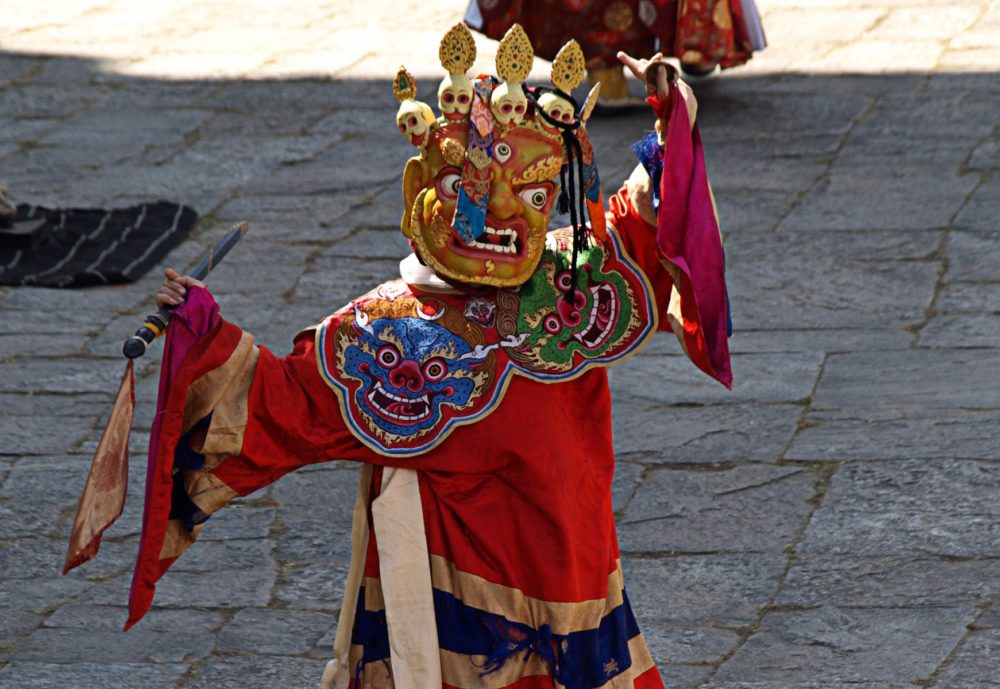
Amazing Festivals Of Bhutan The Kingdom of Bhutan, located on the eastern edge of the Great Himalayan range, is known as the “Land of the Thunder Dragon.” This carbon-neutral nation is also known as the world’s happiest country. Ten beautiful festivals will give further insight into the fantastic Bhutanese culture. Tsechue: It means the 10th day of the month on the Bhutanese calendar. These festivals are held in different cities, and the festival months differ according to each city, town or village. Guru Padma Shambhava, or Guru Rimpoche, the great sage and scholar, visited Tibet and Bhutan in the 8th and 9th centuries. He converted the opponents of Buddhism by reciting mantras, performing rites, and a subjugation dance to conquer local spirits and gods. These festivals commemorate the anniversary of his arrival in Bhutan. 1. Paro Tsechue 17th to 21st March 2019 It is the most famous festival in Bhutan. Trained monks and laypeople wear colourful costumes and masks to perform dances. Witnessing Tsechues is one of the best ways to experience the ancient living culture of Bhutan. The highlight of this festival is the unfurling of a giant Thangka (traditional Tibetan Buddhist painting) that covers the face of the entire monastery. The Thangka, a religious scroll, is displayed to the public. The Bhutanese believe they are blessed with eternal peace by looking at the Thangka. 2. Thimpu Tsechue 8th to 10th October 2019 Tenzing Rabgye established the Thimpu Tsechue in 1670. It is an excellent opportunity to witness the locals gathered to celebrate the festival in their most elegant traditional Gho and Kira (dresses) in the nation’s capital. Moreover, you can observe the elaborate sacred dances in colourful costumes with the locals. The Tsechue in Thimpu is one of the most popular ones. However, if you want to witness a less crowded festival, Punakha’s celebrations are the ones to observe. 3. Punakha Tsechue and Drubchen https://responsibleadventures.com/wp-content/uploads/sites/3119/2019/11/Festivals-of-Bhutan.jpg?auto=compress%2Cformat& Punakha Drubchen 2nd March to 4th March 2019 Punakha Tsechue 7th to 9th March 2019 A Drubchen is another type of celebration in Bhutan. In West Bhutan, Punakha is the winter home of the Chief Abbot of Bhutan, locally known as the Je Khenpo. After several invasions by Tibetan forces in the 17th century to seize a religious relic, Zhabdrung Ngawang Namgyal led the Bhutanese victory. Punakha Drubchen was introduced to commemorate the triumph over the Tibetans, which has continued annually. To maintain the Bhutanese traditions, the locals requested the Government start a Tsechue in 2005. Both these festivals are celebrated with enthusiasm. 4. Jambay Lhakhang 13th November to 16th November 2019 The oldest temple in the Kingdom is the Jambay Lhakhang. They were founded in the 7th century by Songtsen Gonpo, a Tibetan King. Legend has it that a she-demon was obstructing the spread of Buddhism, which compelled the King to build 108 temples on her body across Tibet, Bhutan, and their borders. Jambay Lhakhang is one of the 108 temples. The festival here is unique, with a fire ritual held in the evening, and the crowds gather to witness the naked dance known as Tercham. 5. Jhomolhari Mountain Festival. 14th to 15th October 2019 This festival celebrates the community’s culture that lives together harmoniously with nature. The elusive snow leopard is a symbolic animal as it thrives in this area. Snow leopard-themed school children perform songs and dances during this festival. 6. Black-necked crane festival 11th November 2019 This annual festival is organized to generate awareness and understand the importance of conserving the endangered Black-necked Cranes. This festival is celebrated with cultural programs such as folk songs and dances: some of which are black-necked crane themes. In addition, the locals perform mask dances while the school children perform crane and environmental conservation-themed dramas and songs. This festival is celebrated in the courtyard of Gangtey Gompa in Phobjikha valley. 7. Haa Summer Festival 13th to 14th July 2019 Haa Valley is set amongst pristine lakes and alpine forests. Its lively and uplifting festival celebrates tradition, living culture, nomadic lifestyle, traditional sports, unique local cuisine, and religious performances. With its wild forests and rugged hills, the Haa valley is an excellent location to enjoy some of Bhutan’s best hiking. In addition, you can have a cultural immersion by participating in local sports, sampling local food, and listening to traditional songs. It is located close to the Paro international airport. 8. Nomad festival 23rd February 2020 23rd February 2019 Several nomadic communities at the northern frontier add vibrant colour, traditions, and culture to the nation. Nomadic tribes from Bumthang, Thimpu, Wanduephodrang, Trashigang, and Paro participate in this festival. They dress in traditional costumes, including clothing made from yak wool and “Brokpa” headgear conical. The women wear colourful handwoven aprons decorated and themed with flowers and animals. Colourful ribbons adorn the women’s folk plaited hair. 9. Kurjay Tsechue 11th July 2019 The festival takes place at the temple of Kurjey, which is in the Chokor valley of the Bumthang district. Legend has it that Guru Rimpoche was invited to ward off the evil spirits. Thus, there are imprints of Guru Rimpoche that were left behind after he subdued the demons. The Kurjey festival unites all Bhutanese and foreigners who gather to witness the ancient mask dances while basking in Bhutan’s natural beauty. 10. Pema Gatshel Tshechue 11th to 13th November 2019 Pema Gatshel is a town in East Bhutan. Their festival is celebrated for three days. When the local dancers perform the traditional mask dances, it is believed that the spectators are blessed. It is an annual social gathering to celebrate and contemplate religion.
12 Beautiful Himalayan Lakes
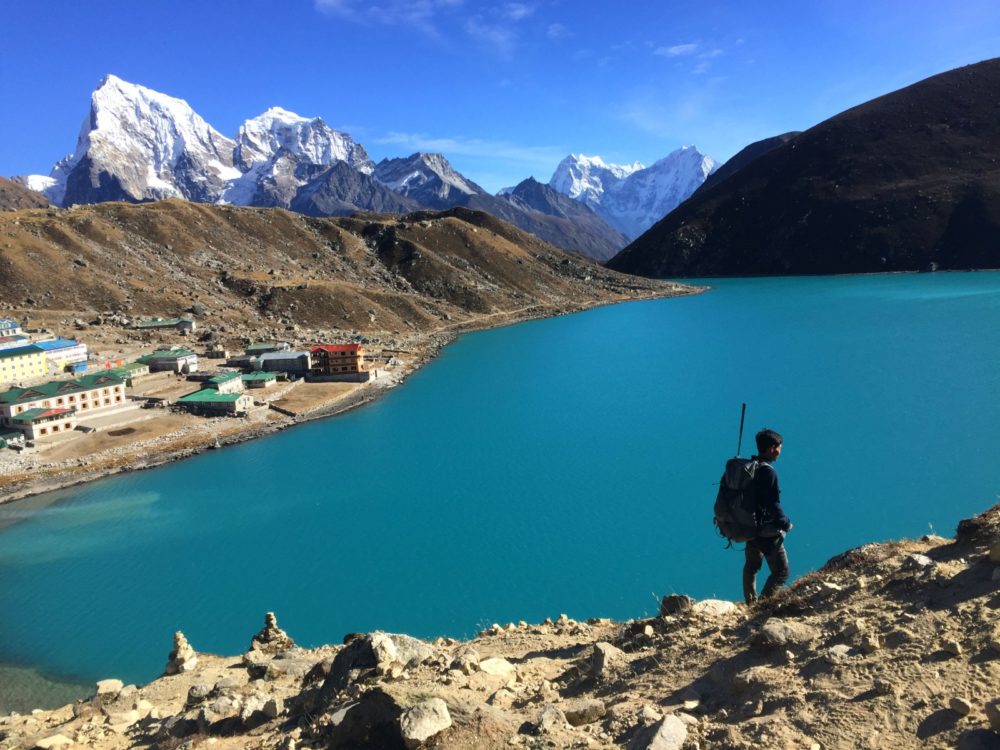
12 Beautiful Himalayan Lakes. Most regular hikers who go hiking around the various mountain ranges know that glacial lakes are part and parcel of the ecosystem. Likewise, the experienced trekkers know some of the most beautiful lakes in the world’s highest mountain chain – The Himalayas. However, many trekkers feel their trip is incomplete when they miss the journey to a Himalayan lake. Here is a list of twelve of the highest, most extensive, and most stunning mountain lakes in the Himalayas. 1. Rara Lake, Nepal Rara lake, at 3060 m, is located in the Mugu District of Far Western Nepal. Rara is the largest and deepest Lake in Nepal. It sits in a valley surrounded by lush forests and stunning mountain vistas. It is so beautiful that being around this surround is hypnotizing. The temperate forests and the alpine pastures that enclose the valley cover the whole area. Thus, trekking around the Rara Lake region is an excellent combination of a pristine lake, mountain vistas, and Himalayan flora and fauna. 2. Gurudongmar Lake, India Gurudongmar Lake, at the height of 5430 m, is amongst the highest lakes in the world, while it is the second-highest lake in Sikkim and India. The second highest lake in India is a sight to behold with the picturesque beauty of the surrounding. The views of Mount Siniolchu and Kanchenjunga are icing on the cake. The surrounding snow-clad mountains and the clear icy water are considered sacred lakes. Gurudongmar lake is about an eight to nine hours drive from Gangtok. First, one has to go through Lachen, a small town in North Sikkim. Most travellers stop at Lachen for the night to help acclimate and break the journey. The closest village to the Lake is Thangu at 4270 m. One needs to attain an inner line permit to visit this lake because of its proximity to the Indo-Tibet border. Legend has it that Guru Padmasambhava touched and blessed the lake, and it is widely believed that a small part of the lake never freezes, even during the extreme winter temperatures at such an altitude. This lake is one of the Teesta river’s primary sources, flowing from Sikkim, West Bengal, and Bangladesh to the Bay of Bengal. It is widely believed that this lake’s water has healing properties; many visitors bring water from this lake back to their homes. 3. Gosainkunda Lake, Nepal Gosaikunda Lake, at 4,380m, is located in the Rasuwa district and is one of the famous pilgrimage sites for Hindus. This freshwater lake is part of a popular trekking route in the Langtang region, north of Kathmandu. It is believed that this region has 108 lakes of various sizes. However, I once met an elderly local who told me he could only count 18 despite spending a few weeks wandering around the area. Hindu mythology considers the Gosainkunda area as the abode of Hindu Deities, Lord Shiva, and Goddess Gauri. Hence, Gosainkunda is called Samudramanthan in the Hindu scriptures and epics such as Bhagavata Purana, Vishnu Puran, Ramayana, and Mahabharata. Janai Purnima is one Hindu festival where thousands of pilgrims from India and Nepal throng this lake. 4. Shey Pokshundo Lake, Nepal Situated at an altitude of 3,611 m, Shey Phoksundo Lake is the second deepest lake in Nepal. This glacial lake is located in Lower Dolpo, one of the most remote and isolated high valleys in the Trans Himalaya. This lake is considered sacred by the residents. Although some say swimming is prohibited, the locals take a bath in this lake. The village of Ringmo sits on the southern edge of the “dam caused by a landslide some 30,000 to 40,000 years ago. About 20 Chortens (Stupas) are on the south side of the lake, leading to an ancient Bon (religion preceding Buddhism) monastery. Just a short distance from the lake’s southern exit is the impressive Siligad Waterfall at 167 m. Eric Valli’sValli’s movie “Caravan or “Himalaya” introduced Shey Phoksundo lake and Dolpo to the world. 5. Tilicho Lake, Nepal Tilicho Lake (4,949m) is one of the highest lakes in Nepal. It is situated on the north side of the Annapurna range bordering with Manang and Mustang districts. It is considered a sacred lake and featured in one Hindu epic – Ramayana. A visit to Tilicho lake can be combined with the Annapurna Circuit Trek. The panorama from the valley’s edge can be second to none on clear days. Views of Annapurna II, III, IV, Ganga Purna, Himalchuli, Manaslu, Himlung, and Chulu West can be breathtaking. 6. Gokyo Lakes, Nepal The Gokyo lakes are six Lakes at the foothills of the Mahalangur range in the Everest Region. Dudh Pokhari, also called Gokyo Lake, is most frequented by trekkers. It is on the less frequented trail away from the main path to the Everest Base Camp trek. These lakes are situated between 4700 to 5000 meters above sea level. These lakes are the world’s highest freshwater lake system comprising six leading lakes, of which Thonak Tsho is the largest. The Gokyo and associated wetlands were designated a Ramsar Site. 7. Namtso Lake, Tibet Namtso Lake is one of the most beautiful natural sites in Tibet. Namtso is one of the most beautiful natural sights in Tibet. It is said that it is the largest high-altitude brackish lake in Tibet, with 4718 m. Namtso is one of the three sacred lakes of Tibet. The crystal clear water, the surrounding snow-capped peaks, and yak herds of locals make it a charming picture-perfect spot. The sunrise and sunset at the lake can be breathtakingly gorgeous. Witness the magic when the sky turns golden and red at dusk. If you can take the cold at night, stare away at the millions of stars in the sky. 8. Mansarovar Lake, Tibet Lake Manasarovar, situated approximately 30km from Mt. Kailash, is one of the world’s highest freshwater lakes. The sacred lake is an important pilgrimage site for Buddhists and Hindus. It is believed that bathing in the
5 Yoga poses to calm your mind
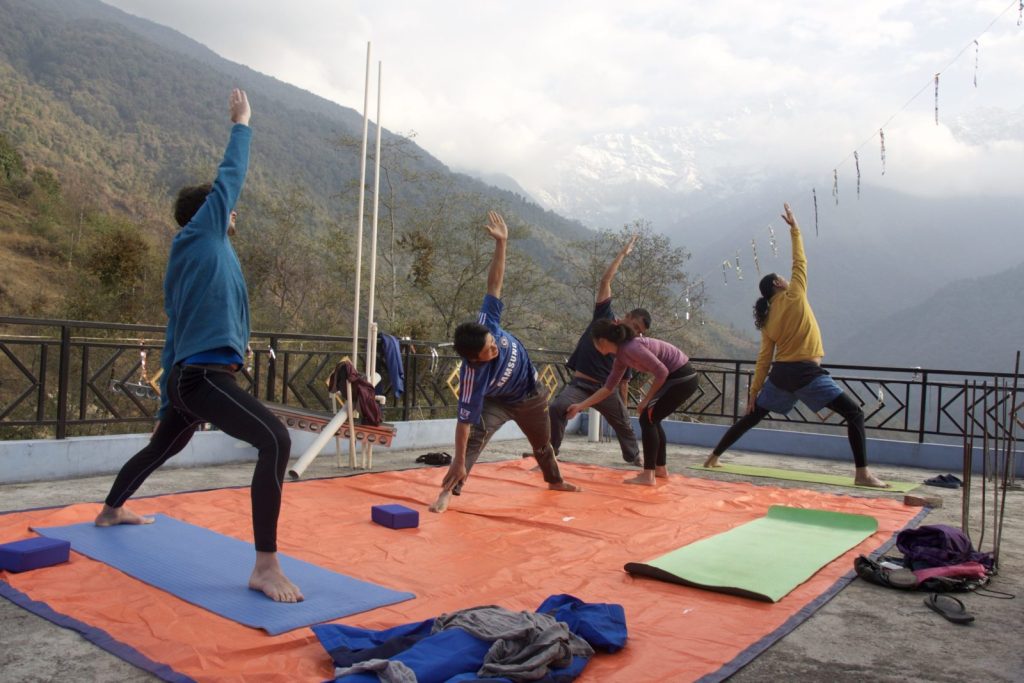
5 Yoga Poses to Calm Your Mind Yoga / By Sophie Addison When people are liable to anxiety, depression, and stress, it is more essential than ever to seek ways to relax the mind. Relationships, school, work, and financial worries take a toll on our bodies and minds. Yoga can be a pleasant break from the tensions of our daily life. According to one study, practising yoga regularly can help fight anxiety, depression, and stress. In addition, yoga can benefit the overall calming of your mind; these five poses have been selected, making a difference in lowering your overall stress levels when practised mindfully. Child’s Pose Extending your lower back and hips by this pose can be very relaxing and help decrease weariness. First, sit on your heels while leaving a gap between your thighs to try out this pose. Next, extend your upper body on the floor with your midsection resting between your thighs and your arms entirely on the floor. Take a few long, deep breaths in this posture. This pose can be held up to five minutes or longer if you wish. Cobra Pose This is a challenging pose but compelling at the same time. It boosts your mood and energy level while strengthening your back. Lie with your face down, positioning the palms on the floor at the width of your shoulders for the cobra pose. Place your lower body and pelvis on the ground throughout, take a deep breath, and lift your chest off the floor while keeping your body in the same place. The attention should be on raising from your core rather than just resting on your arms. You can take several long deep breaths while holding this pose, then let the body rest on the floor while you exhale. Warrior II There are three types of warrior poses. Warrior two is a natural yoga pose that helps to release stress and tension. Remind yourself of your inner strength and the capability to stand with tenacity against life’s challenges. Dancer’s Pose This is an excellent yoga posture, not just for dancers. Anyone can apply this yoga pose to their regular practice. It is a charming pose that symbolizes elegance and grace. You can do this pose as if you were a dancer with a light and happy feeling. The dancer’s pose not only helps to release stress but also opens up the chest. Crow Pose This is a mighty pose, which is not an easy pose to do. You will appreciate yourself when you finally execute the crow pose, despite the time and practice it will take. This pose improves your concentration, focus, and strength. Observe your mind turn calm and happy while doing this pose. This state of mind is known as Prasanna Chetana, p relaxed and pleasant awareness. Having an alert mind can also help you to overcome the symptoms of depression. Emotional and mental health is as important as physical health. Stress can affect our mental as well as physical well-being and inner peace. Practising yoga regularly can help in managing, which in turn lowers the risk of stress-related health problems. Sophie Addison is a skincare expert and blogger who is passionate about sharing her knowledge. She has written about everything from joint pain treatments to wrinkles to weight loss and fitness news. In addition, she listens to music and loves to do gardening. This article was first posted on the Art of Living Retreat Center’s Website and is republished with the authors’ permission. Check out our Trekking packages for Nepal, Bhutan, India, and Tibet.
12 Most Prominent and Popular Festivals Of Nepal
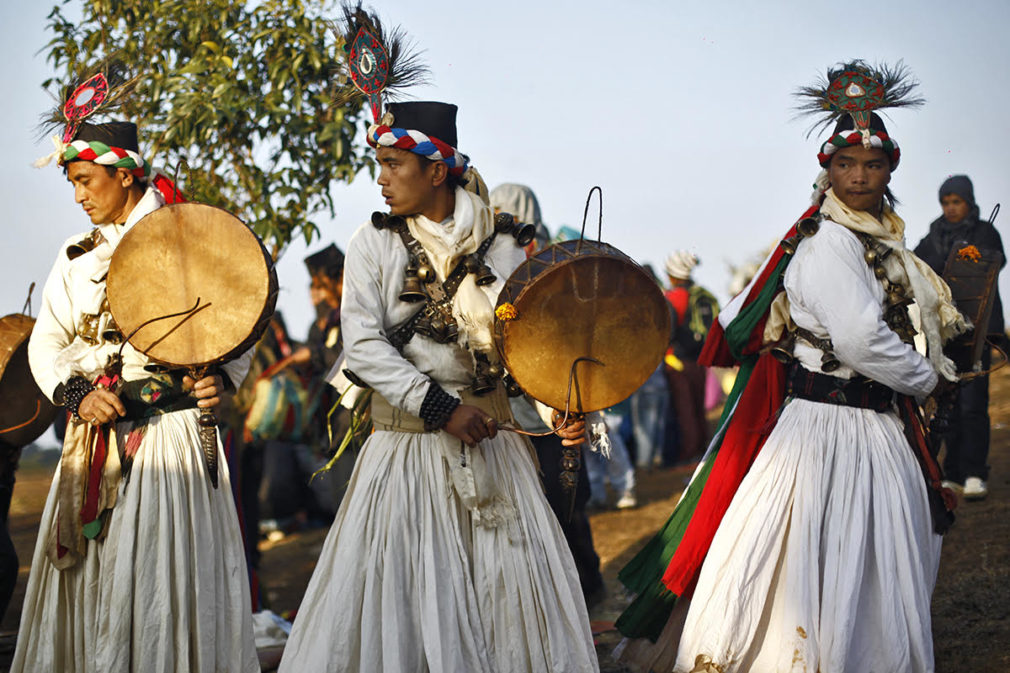
12 Most prominent and Popular Festivals Of Nepal Nepal is known for its numerous grand festivals that are colourful and vibrant. Most of the major festivals celebrated in Nepal have a religious connection based on ancient mythology for several millennia. Most of these festivals are Hindu and Buddhist, but it has recently included Muslim and Christian holidays into the national calendar as a secular nation. Despite the diverse ethnic background and practices, most citizens unite to celebrate major festivals. Dashain and Diwali (Deepavali) are the most prominent celebrations for Hindus throughout the nation. In the old towns of Kathmandu valley, the Newar community celebrates festivals such as Bisket Jatra, Rato Machendranath, and Seto Machendranath. Here are some of the principal/central festivals of Nepal. Dashain and Tihar Dashain 2020 – 5th October – 8th October Tihar 2019 – 25th October to 29th October These two are the biggest and most popular festivals of the Hindus in Nepal. Like many religious festivals worldwide, Dashain is a celebration of Goddess Durga’s victory over evil. It has a symbolic meaning that is deeply rooted in Nepalese society. Tihar or Diwali is a festival of lights and colours dedicated to Goddess Laxmi, the goddess of wealth. Buddha Jayanti or Vesak Day – 19th May 2019 Buddha Jayanti is celebrated to mark the triple celebration of Lord Buddha, his birthday, the day of his enlightenment, and Nirvana. It falls on the whole moon night of May, mostly and occasionally in June. The Buddhist communities pilgrimage to Buddha’s birthplace, Lumbini and Swayambhunath and Boudhanath Stupas in Kathmandu valley. Gai Jatra 19th August 2019 The festival of cows is another famous festival celebrated between August / September. Cows are marched on the streets of Kathmandu on this festival to commemorate the dead. Even though the Tharu community honours Gai Jatra, the Newar community of Kathmandu valley celebrates it with the most vigour. Janai Purnima 15th August 2019 Janai Purnima is the festival when the Brahmin and Chettri men change their Janai (sacred thread) after bathing in a river in Nepal. It is also known as Raksha Bandhan, where sisters pray for the long life of their brothers. It usually takes place in early August. Teej 1st September 2019 Teej is celebrated by women of Nepal annually. The women in Nepal celebrate it with dedication and love. Preparations for the festival begin well in advance. Shops that sell sarees, fabrics, and shoes are stocked up with most things red as it is life’s colour. When Teej approaches, women go on a shopping spree followed by sumptuous feasts. On the day of Teej, women dress up beautifully in their red outfits and glass bangles and display their heavy ornaments, like traditional Nepalese brides. This festival is held for three days. On the first day, they feast, fast on the second day, and perform the “Rishi Panchami” puja for their husbands’ marital bliss and long life. Krishna Janmashtami 23rd August 2019 Krishna Ashtami is observed to mark the birth of Lord Krishna. He is considered to be one of the ten incarnations of Lord Vishnu. The Hindus celebrate this festival with much fanfare in Nepal and neighbouring India. Devotees of Lord Krishna fast or only consume fruits and dairy products on this day. They visit temples dedicated to him in large numbers by carrying idols and images of Krishna. Traditional musicians often accompany them. It usually falls in August / September. Fagun Purnima or Holi 20th March 2019 The ancient Hindu festival of Holi falls in either late February or early March. It is in celebration of the death of the mythical demoness Holika. It is a weeklong celebration. All observe the last day with coloured powders and water sprays. Read more on Holi Maghe Sankranti 15th January 2020 15th January 2019 Maghe Sankranti is also called Makar Sankranti. It is observed yearly on the first month, Magh, which usually falls around the 15th of January. The celebration marks the end of the supposed ill-omened month Poush in which all religious ceremonies are forbidden for the Hindus. Even though Magh’s 1st is considered the coldest day of the year, the celebration welcomes warmer and better days for health and fortune. The festival is famous not only in Nepal but amongst Nepalese communities worldwide. It also is a celebration of the days getting more prolonged than the nights. People take holy dips in rivers all over Nepal, despite the cold. The festival’s unique delicacies are yam, chaku (sweet prepared from boiled and hardened molasses), chaku-sesame candy, and ghee. Indra Jatra 12th September 2019 Indra Jatra is the festival to worship Lord Indra. He is considered to be the God of Rain and King of Heaven. Therefore, celebrating this festival is believed to thank Indra for the rain and to make him happy. It is an eight-day festival at the end of August or early September. The eighth-day festival also coincides with the Kumari Jatra – the procession of the Living Goddess. Another significant event of this festival is Kumari Jatra (the procession of a living goddess). King Jaya Prakash Malla started this tradition in 1756 AD. Three chariots of Ganesh, Bhairav, and goddess Kumari are pulled along the Kathmandu festival route for three days, accompanied by musical bands and dancers. The three days of the chariot-pulling procession cover different festival routes, and each day’s celebration ends back at Basantapur. Mahashivaratri 4th March 2019 It is also known as “The Night of Shiva.” This Hindu festival is celebrated annually with a deep respect for Lord Shiva. Devotees sing devotional songs to honour and worship Lord Shiva and sanctifying rituals throughout the night. For the devotees of Shiva, this is the most auspicious day of the year. It is believed that whoever worships him with sincere devotion will be rid of all sins and be blessed with Nirvana or Moksha (liberation from the eternal cycle of life and death). Shivratri is the night he is believed to have performed a divine dance of
10 UNESCO World Sites of Nepal
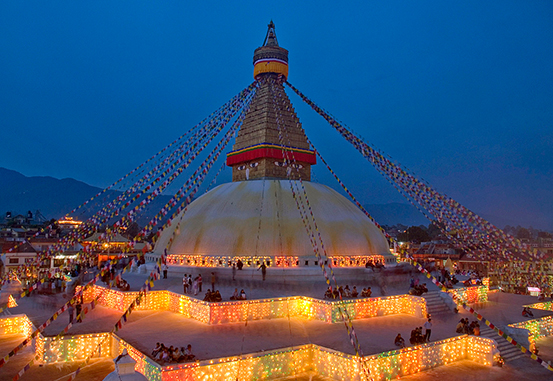
UNESCO has chosen 10 World Heritage sites, including seven ancient sites in the Kathmandu Valley, Lumbini – The Birthplace of Lord Buddha, Chitwan National Park, and Sagarmatha National Park. These heritage sites have been chosen based on their cultural and natural values. The list of Cultural World Heritage Sites: 1. Kathmandu Durbar Square In the centre of Kathmandu – Kathmandu Durbar Square, which has Hanuman Dhoka, Degutale Temple, Taleju Mandir, Nasal Chowk, Nine story Basantapur Tower, Panch Mukhi Hanuman Temple, Mul Chowk, Mohan Chowk, Sundari Chowk, Tribhuvan Museum, King Mahendra Memorial Museum, and Kal Bhairab temple in its vicinity. The Hindu Mythology claims that there would be an instant flow of milk from the wall where a single person translates the 17th-century inscription on a stone on the walls of Hanuman Dhoka. Hanuman Dhoka, the former Royal Palace of the Malla kings, passed on to the succeeding Shah dynasty. The Royal family lived in the Hanuman Dhoka palace until 1886 and shifted to The Narayanhiti Palace. However, the former is still used for ritual and ceremonial occasions. New Kings were crowned inside the palace before Nepal became a Republic. The palace has a Hanuman statue from the 17th century to the left of the palace entrance and a fantastic sculpture of Lord Narasimha. The palace bears the historical reminisce of Nepal’s Royal family, culture, and religion. The museums inside the palace let one explore the culture, religion, customs, tradition, architecture, history of Royal palaces, etc. There is an entrance fee to enter the museums. The museums remain open seven days a week except for Tuesdays, when it opens from 10.30 am to 3 pm during the winter and from 10.30 am to 4 pm in the summer. One can visit the museums on Fridays from 10.30 am to 2 pm. 2. Patan Durbar Square Patan Durbar Square lies 5 km South-East of Kathmandu Valley by Bagmati River. Four hundred fifty-nine hectares of Patan are bounded by Emperor Ashoka’s four stupas in the 3rd century B.C, as recorded in history. Patan is also called Lalitpur – City of fine arts. There are several legends attached to the origin of the term Lalitpur. One such legend says that when Kathmandu was engulfed with severe drought in ancient times, three people were assigned to summon God Red Machhendranath into the valley for rainfalls from Kamaru Kamachhya in Assam, India. Amongst the three people, one was a farmer named Lalit, who is believed to have contributed more than the other two. When rains finally poured into the valley, people, as a sign of gratitude, Sanskritized the valley after his name and the term ‘pur’, meaning township, and it was subsequently named Lalitpur. Another tale claims that the valley was named after King Yalamber. The denizens refer to Patan as Yala. History shows that Patan was founded in the 3rd century by the Kirat dynasty and later modelled into perfection by Lichhavis during the sixth century, followed by the Malla dynasty. This city presents a potpourri of the most exquisite traditional crafts and rich artistic heritage. Patan Durbar Square consists of Mahaboudha Temple, Kumbeshwor temple, Krishna Temple, Golden Temple of Hiranya Varna Mahavihar, Mulchowk, Jagat Narayan Temple, Big Bell, Pillar of Yognarendra Malla, Hari Shanker temple, Vishwanath temple, Bhimsen temple, Marga Hiti, Mani Mandap, Café Pagoda, Rato Machhendra Temple, Minnath, Rudra Varna Mahavihar. These are the major attractions of Patan. 3. Bhaktapur Durbar Square Bhaktapur lies 13 km in the Eastern part of the Kathmandu valley. It is also known as Bhadgaon or Khwopa. It is regarded as the abode of ancient Nepali culture, custom, and alluring art pieces of excellent craftsmanship. Each historical monument represents Nepal’s medieval culture, religion, and tradition. The Newari populace dominates Bhaktapur. Bhaktapur is the only place in Nepal which has remained untouched by western culture. Lion Gate, Golden Gate, Art Gallery, Statue of King Bhupatindra, Nyatapola Temple, and fifty-five windowed Malla palaces are the pride of Bhaktapur. The place has some excellent restaurants and hotels to cater to the needs and requirements of tourists. 4. Swayambhunath Stupa Swayambhunath stupa lies just 3 km westward from Kathmandu’s city centre. Ancient legend has it that it was an island a couple of thousand years ago. A stupa was built later. King Manadeva contributed to the making of the stupa in 460 AD. However, after the Mughal invasions, it was destroyed and had to undergo renovations in the 14th century. In the 17th century, King Pratap Malla further enhanced the architecture and added a stairway to the stupa. The stupa is a solid hemisphere of brick and clay, supporting a lofty conical spire capped by a copper gilt pinnacle and has Lord Buddha’s eyes painted on all four sides of the spire base. The Buddhists regard it as one of the holiest places. Swayambhunath also offers a majestic view of the entire Kathmandu valley on clear days. 5. Pashupatinath Temple Pashupatinath temple is a temple of Lord Shiva and is the holiest place shrine for Shiva. The sacred temple lies on the sacred Bagmati River banks, 5 km east of Kathmandu city. Non-Hindus are strictly prohibited from entering the temple. It has a two-tiered roof and four silver doors. However, Hindu devotees from around the world come here to pay their homage to Lord Shiva. 6. Boudhanath Stupa Boudhanath stupa epitomizes Tibetan Buddhism. It lay 8 km East of Kathmandu and was built by a Licchavi King Man Dev in the 5th century A. D. The colossal and ancient stupa is regarded as one of the world’s biggest stupa and has been built on a stepped octagonal base and inset with alcoves representing the Mandala. Tibetans came in thousands to this famous Buddhist Chaitya after the Chinese invasion of Tibet and energized the stupa. Various temples or ‘gompas’ surrounds the stupa. The whole place’s atmosphere lightens with zest as the fragrance of incense drifts through the air. Chanting monks and the creaking of prayer wheels can be heard while strolling around the stupa’s base. It is one
How to handle arriving at Kathmandu airport
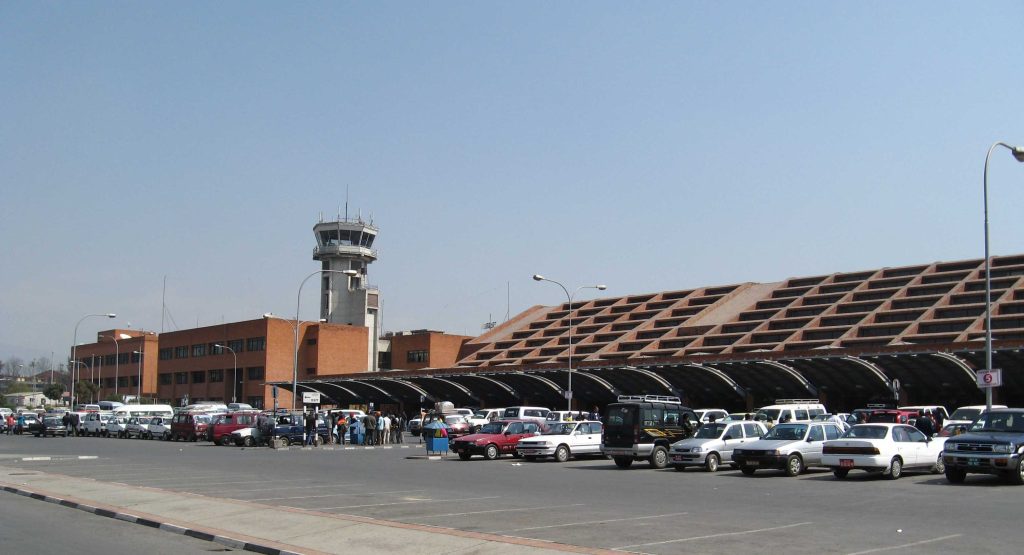
Arrival at Kathmandu airport What to expect at Kathmandu Airport It can be a daunting experience if you arrive at Kathmandu’s Tribhuvan International Airport for the first time after a long flight. The queues can be disorderly and unorganised. When you fly into Nepal, getting sorted out can be a rite of passage. You will soon notice that the International airport is busy and see its wear. One needs to be patient, assert your ground in lines, and ask when you are unsure where to go. Do not let the frustratingly disorderly entry process dishearten you; Nepal is a beautiful and exciting country waiting to be explored just a few steps away. Rest assured, you will have a great time soon. Standing in Lines. Look for the small signboards above the counters that are in the front; don’t jump into the first long queue. Instead, ask others in the line which part of the process they are waiting for. It can be frustrating to wait 30 minutes or more before you finally reach the desk and get told you are supposed to be on another counter. Don’t be surprised if the waits are long, disorderly, and impolite. You might have to shuffle your feet and perhaps even stick your elbows out to stop others from trying to cut the line to go in front of you. Arriving at the Immigration Hall. The flight crew of your airline should have given you a customs declaration and visa form. Filling them on board your flight will provide you with a significant advantage. If you didn’t get the forms, you would find English versions among the paper piles on the tables where others fill out their paperwork. In the unlikely case of not seeing the forms on the tables, go to the front of the queue and get one from the immigration counter. Advice: Always keep passport-sized photos, a pen, and your passport accessible to complete any paperwork. If you don’t have a passport-size picture, you will need to fight for one of the electronic booths on the left. It saves time if you have a photograph with you. Bring several passport-sized photos, as they can be helpful in Nepal, especially if you plan to get a local SIM card or trekking for other purposes. Hold your boarding pass with the luggage tag; you need it to claim your bags. These days, you can fill out the Nepal visa on arrival form online and print it before arriving in Nepal. However, there have been complaints of problems with the form, including that it isn’t on a secure HTTPS website. So you will probably still need to pick up the arrival card and complete it in the arrival hall. Visa on arrival for Nepal You will need to get a visa on arrival unless you have organised a tourist visa at a Nepalese embassy in your residence before arriving in Nepal. Nepal’s online visa form is an option, but filling out a paper form is better until better electronic security is enforced. You must know your hotel’s exact address in Kathmandu, whether you fill out a visa-on-arrival form online, in a booth, or on paper. Keep the hotel address handy from the guidebook and email confirmation from the booking website. Payment for Visa on arrival After completing the forms, you will have to approach one of the counters to pay the visa fee, and the preferred currency is U.S. dollars in cash. They accept some major currencies; however, you will get an unfavourable exchange rate. So have the exact amount handy, and make sure the notes are crisp, not too wrinkled or torn. If your currency is not accepted, there is a small currency exchange window to the right of the counter. Unfortunately, exchange rates at airports are not favourable most of the time. Whether you have opted for an online visa or a visa on arrival, the time it takes you to get through the queue is a draw of luck. Visa on arrival fees: 15 days: U.S. $30 30 days: U.S. $50 90 days: U.S. $125 Citizens of SAARC countries do not have to pay for a visa. Indian nationals don’t need access to enter Nepal. The visa fees for Chinese tourists were waived in 2016. Put the receipt and go to the next counter to give all paperwork, photos, and receipts to an immigration officer. Your will visa on arrival will be issued—exit to the left towards the escalators, which bring you down to the baggage claim area. Luggage Collection You might expect your luggage to be circulating on the carousel since it took you a long time to get your Visa; when numerous flights land in Kathmandu, people have to wait up to two or more hours. Fortunately, these incidents are not frequent. Keep your luggage tag handy if asked to show it when you claim your bag. There should be free trolleys in the baggage claim area. Some porters could offer to carry your bags or to “rent” you a free trolley. Exiting the arrival terminal You will have to go through either a green or red channel depending on if you have to declare something to the customs. Sometimes, the customs officers wave you to go on, while on others, they ask you to put your bags through the X-ray machine. You will have to walk through a walkway to the new Arrival terminal. There is a cell phone company where you can get a SIM card and a currency exchange counter on your right side; exchange only $10-20 if you need to pay for your taxi, then use an A.T.M. for a better rate afterwards. You will have to produce your passport to exchange money. You will need the receipt to exchange any local currency for U.S. dollars. You can book a prepaid taxi via several nearby counters. The prepaid taxi fares are fixed; you don’t have to worry about being ripped off. It is less










